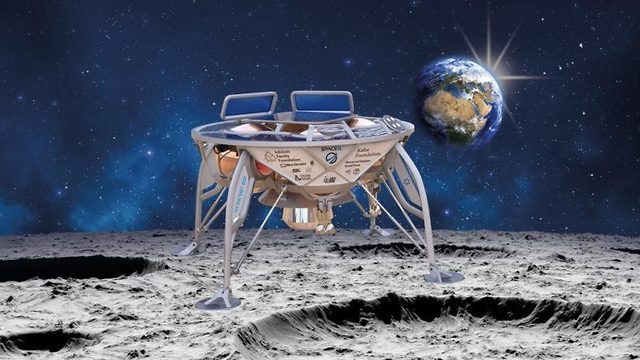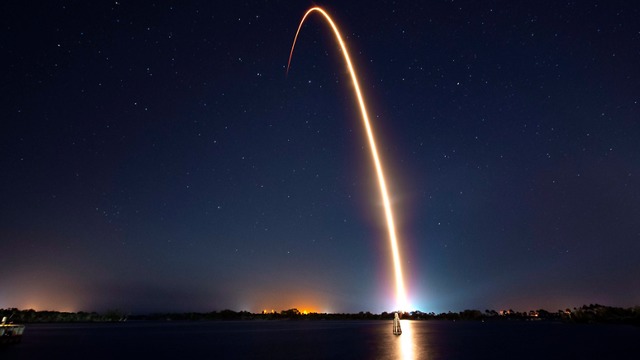
An artist’s rendition of the Beresheet spacecraft on the lunar surface
Photo: SpaceIL

Israel’s ‘Beresheet’ spacecraft faces hurdles ahead of historic moon landing
Industry experts say crucial challenges remain before planned landing of Israel’s Beresheet spacecraft in April; the probe already ran into technical difficulties when its computer system unexpectedly rebooted, causing the craft to miss a scheduled maneuver to send it into an elliptical orbit around the Earth.
Crucial tests await Israel’s Beresheet spacecraft before it can successfully complete its historic mission, among them entering the moon’s orbit and then effecting a complex autonomous landing on the celestial body’s surface.
Last week, the probe already ran into technical difficulties when its computer system unexpectedly rebooted, causing the craft to miss a scheduled maneuver to send it into an elliptical orbit around the Earth. While ground control eventually managed to set Beresheet back on course, Eran Schmidt, Deputy Project Manager of SpaceIL and Head of Ground Operations, conceded that other problems remain unresolved.
“We’re getting measurements but we need to filter (out ones that are incorrect),” Schmidt said. “We’re managing to work with this issue but it does present a small risk to the navigation".
“Second, we’ve had several computer resets (which were likely) the result of…radiation. We are trying to find a way that even if this occurs before a maneuver, we will not have to abort.”
Schmidt said that the major challenges still lie ahead of the April 11 scheduled landing, specifically a process known as “lunar capture.” During this phase, Beresheet will be pulled into the moon’s orbit by its gravity. This is expected to take place in early April and requires “perfect timing and positioning” roughly 250,000 miles away, according to Schmidt.
“The landing itself is a huge, huge test,” he said. “We are going to send a command to the spacecraft to start (descending) and afterwards we will have 20 minutes when everything will work autonomously. So we need the sensor measurements to be good, the control system to act properly and we hope that we will not land in the middle of a crater on a rock. We are not in a position to forego the landing if we see something is not working correctly.”
Tal Inbar, an Israeli space expert, also said “lunar capture” as a crucial technical test and agreed that other milestones must be surpassed.
“Each part of a space mission has its own challenges and difficulties,” Inbar told The Media Line. “Each day that the space craft moves towards the moon, the dosage of radiation from the sun and from cosmic (sources) is higher and higher. After a successful landing, the main challenge will be the heat. The spacecraft won’t (be operational) for long on the surface of the moon because it was not built to withstand the extreme temperatures there.”
Beresheet (named after the first chapter of the Hebrew bible) was launched from the U.S. Air Force Base in Cape Canaveral, Florida, on the night of February 21. The four-legged robotic probe is roughly the size of a washing machine, weighs 1,100 lbs., and initially hitched a ride on a Falcon 9 rocket made by Elon Musk’s SpaceX company.
“As we better understand Israel’s capabilities and the innovative work of its private industry, we know they’ll be an even stronger international partner in the future, one vital to the success of extending commercial space to the Moon and eventually on to Mars and beyond,” NASA Administrator Jim Bridenstine said in a recent statement about Beresheet’s mission. “There are terrific opportunities awaiting Israel and all of us in advancing the space frontier.”
A joint venture between SpaceIL and the state-owned Israel Aerospace Industries (IAI), the $100 million probe was funded almost entirely through private donations from Jewish philanthropists. If successful, Israel will join the United States, the former Soviet Union and China as the only countries to land a craft on the moon.
Once achieved, the probe will collect scientific data, including measurements of the magnetic field that could help scientists better understand how the moon was created some 4.5 billion years ago.
Despite the ongoing technical issues, Schmidt says SpaceIL was “born for this mission.”
“(Beforehand), I could not imagine everybody around the world looking at us as pioneers for private and commercial space companies,” he concluded.
Article written by Maya Margit
Reprinted with permission from The Media Line


















